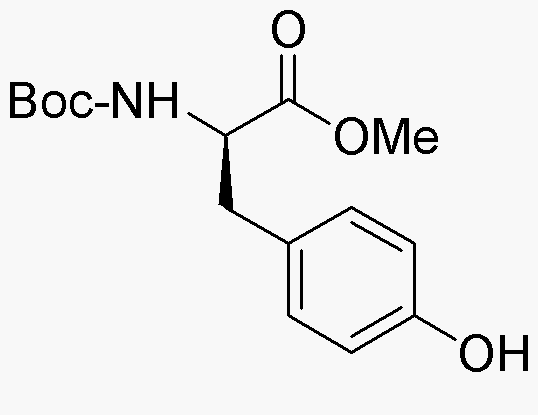Boc-D-tyrosine methyl ester is widely utilized in research focused on:
- Peptide Synthesis: This compound serves as a key building block in the synthesis of peptides, particularly those that require protected amino acids. Its protective Boc (tert-butyloxycarbonyl) group allows for selective reactions, enhancing the efficiency of peptide formation.
- Drug Development: In pharmaceutical research, it is used to create analogs of bioactive peptides, which can lead to the development of new therapeutic agents. Its ability to modify the structure of peptides can improve their efficacy and stability.
- Bioconjugation: The compound is employed in bioconjugation processes, where it can be linked to other molecules, such as drugs or imaging agents. This application is crucial in targeted drug delivery systems, enhancing the specificity of treatments.
- Research in Neuroscience: Given its relation to tyrosine, it is used in studies exploring neurotransmitter pathways and their implications in neurological disorders, providing insights that could lead to novel treatments.
- Cosmetic Formulations: Its derivatives are explored in cosmetic chemistry for their potential antioxidant properties, contributing to skin health and anti-aging products, appealing to the growing demand for effective skincare solutions.
Informations générales
Propriétés
Sécurité et réglementation
Applications
Boc-D-tyrosine methyl ester is widely utilized in research focused on:
- Peptide Synthesis: This compound serves as a key building block in the synthesis of peptides, particularly those that require protected amino acids. Its protective Boc (tert-butyloxycarbonyl) group allows for selective reactions, enhancing the efficiency of peptide formation.
- Drug Development: In pharmaceutical research, it is used to create analogs of bioactive peptides, which can lead to the development of new therapeutic agents. Its ability to modify the structure of peptides can improve their efficacy and stability.
- Bioconjugation: The compound is employed in bioconjugation processes, where it can be linked to other molecules, such as drugs or imaging agents. This application is crucial in targeted drug delivery systems, enhancing the specificity of treatments.
- Research in Neuroscience: Given its relation to tyrosine, it is used in studies exploring neurotransmitter pathways and their implications in neurological disorders, providing insights that could lead to novel treatments.
- Cosmetic Formulations: Its derivatives are explored in cosmetic chemistry for their potential antioxidant properties, contributing to skin health and anti-aging products, appealing to the growing demand for effective skincare solutions.
Documents
Fiches de données de sécurité (FDS)
La FDS fournit des informations de sécurité complètes sur la manipulation, le stockage et l’élimination du produit.
Spécifications du produit (PS)
Le PS fournit une description complète des propriétés du produit, notamment sa composition chimique, son état physique, sa pureté et les exigences de stockage. Il détaille également les plages de qualité acceptables et les applications prévues du produit.
Certificats d'analyse (COA)
Recherchez des certificats d'analyse (COA) en saisissant le numéro de lot du produit. Les numéros de lot et de lot se trouvent sur l'étiquette d'un produit, après les mots « Lot » ou « Lot de fabrication ».
Numéro de catalogue
Numéro de lot/série
Certificats d'origine (COO)
Ce certificat d'exploitation confirme le pays dans lequel le produit a été fabriqué, et détaille également les matériaux et composants utilisés et s'il est issu de sources naturelles, synthétiques ou autres sources spécifiques. Ce certificat peut être requis pour les douanes, le commerce et la conformité réglementaire.
Numéro de catalogue
Numéro de lot/série
Fiches de données de sécurité (FDS)
La FDS fournit des informations de sécurité complètes sur la manipulation, le stockage et l’élimination du produit.
DownloadSpécifications du produit (PS)
Le PS fournit une description complète des propriétés du produit, notamment sa composition chimique, son état physique, sa pureté et les exigences de stockage. Il détaille également les plages de qualité acceptables et les applications prévues du produit.
DownloadCertificats d'analyse (COA)
Recherchez des certificats d'analyse (COA) en saisissant le numéro de lot du produit. Les numéros de lot et de lot se trouvent sur l'étiquette d'un produit, après les mots « Lot » ou « Lot de fabrication ».
Numéro de catalogue
Numéro de lot/série
Certificats d'origine (COO)
Ce certificat d'exploitation confirme le pays dans lequel le produit a été fabriqué, et détaille également les matériaux et composants utilisés et s'il est issu de sources naturelles, synthétiques ou autres sources spécifiques. Ce certificat peut être requis pour les douanes, le commerce et la conformité réglementaire.


